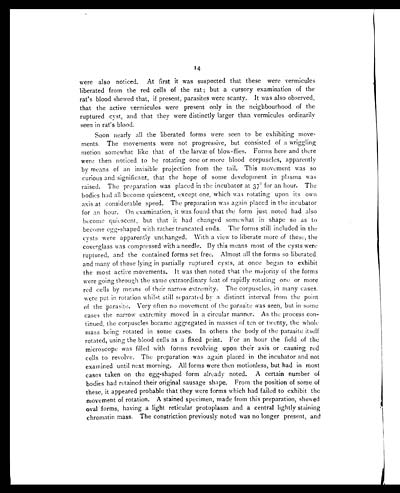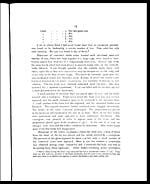Medicine - Institutions > Army health reports and medical documents > Scientific memoirs by officers of the Medical and Sanitary Departments of the Government of India > Number 18 - Haemogregarina gerbilli > Haemogregarina gerbilli
(22) Page 14
Download files
Individual page:
Thumbnail gallery: Grid view | List view

14
were also noticed. At first it was suspected that these were vermicules
liberated from the red cells of the rat; but a cursory examination of the
rat's blood shewed that, if present, parasites were scanty. It was also observed,
that the active vermicules were present only in the neighbourhood of the
ruptured cyst, and that they were distinctly larger than vermicules ordinarily
seen in rat's blood.
Soon nearly all the liberated forms were seen to be exhibiting move-
ments. The movements were not progressive, but consisted of a wriggling
motion somewhat like that of the larvæ of blow-flies. Forms here and there
were then noticed to he rotating one or more blood corpuscles, apparently
by means of an invisible projection from the tail. This movement was so
curious and significant, that the hope of some development in plasma was
raised. The preparation was placed in the incubator at 37° for an hour. The
bodies had all become quiescent, except one, which was rotating upon its own
axis at considerable speed. The preparation was again placed in the incubator
for an hour. On examination, it was found that the form just noted had also
become quiescent, but that it had changed somewhat in shape so as to
become egg-shaped with rather truncated ends. The forms still included in the
cysts were apparently unchanged. With a view to liberate more of these, the
coverglass was compressed with a needle. By this means most of the cysts were
ruptured, and the contained forms set free. Almost all the forms so liberated
and many of those lying in partially ruptured cysts, at once began to exhibit
the most active movements. It was then noted that the majority of the forms
were going through the same extraordinary feat of rapidly rotating one or more
red cells by means of their narrow extremity. The corpuscles, in many cases,
were put in rotation whilst still separated by a distinct interval from the point
of the parasite. Very often no movement of the parasite was seen, but in some
cases the narrow extremity moved in a circular manner. As the process con-
tinued, the corpuscles became aggregated in masses of ten or twenty, the whole
mass being rotated in some cases. In others the body of the parasite itself
rotated, using the blood cells as a fixed point. For an hour the field of the
microscope was filled with forms revolving upon their axis or causing red
cells to revolve. The preparation was again placed in the incubator and not
examined until next morning. All forms were then motionless, but had in most
cases taken on the egg-shaped form already noted. A certain number of
bodies had retained their original sausage shape. From the position of some of
these, it appeared probable that they were forms which had failed to exhibit the
movement of rotation. A stained specimen, made from this preparation, shewed
oval forms, having a light reticular protoplasm and a central lightly staining
chromatin mass. The constriction previously noted was no longer present, and
Set display mode to: Large image | Zoom image | Transcription
Images and transcriptions on this page, including medium image downloads, may be used under the Creative Commons Attribution 4.0 International Licence unless otherwise stated. ![]()
| Permanent URL | https://digital.nls.uk/75027439 |
|---|
| Shelfmark | IP/QB.10 |
|---|---|
| Additional NLS resources: | |




